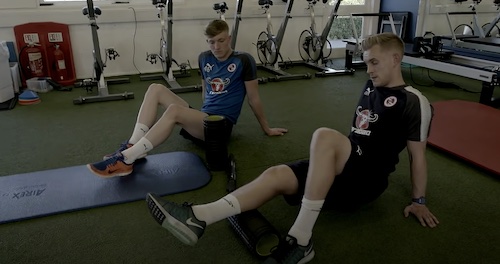Soccer recovery steps: For you to play your best soccer and be at your best for your soccer matches, it is important that you train and work hard. But it is important to remember that training hard every day without adequate rest is not good preparation and can lead to over training and an injury. Let’s look at what exactly entails a soccer training recovery program.
From how to stretch to what to eat, Reading FC’s lead academy sports scientist Ollie Harrington and Science in Sport nutritionist Ted Munson show you how to speed up your recovery.
Here’s a quote from Don Hutchison of West Ham United and Scotland made 5th December, 2002 about the need for recovery:
“I’ve been fed up this week, because I would’ve been fit enough to be considered for Monday’s match at home to Southampton but for a tough training session the morning after our reserve game against Coventry City last Tuesday.
We didn’t perform well in the 1-1 draw, and subsequently we had to do a running session the next day. Unfortunately our muscles were still tight from the night before and four players went down with muscle injuries, which is a disaster considering our current injury problems.
I strained my hamstring – which is still bruised – and Freddie Kanoute, Gary Breen and a young pro all picked up strains too. Looking back we probably should have taken it a lot easier and it’s very frustrating to think my comeback has been delayed again.”
Even fit, professional soccer players, need rest and recovery after matches and soccer training sessions. Ignoring strains, tiredness and stiffness can lead to overtraining and injuries. Even Lionel Messi, who hates to miss games or practices, knows he has to take care of his body and rest on off days. Just much should soccer players rest? Listen to what your body is telling you. Don’t over due it. Alter your training so you’re not wearing down your body, maybe just juggle or work on skills and tricks one day a week so you get a rest day.
Train hard but soccer players must also plan recovery sessions. This way you’ll reduce the risk of injuries and also reduce the risk of over training and burn out. Soccer coaches should provide recovery sessions and guide you in your recovery phases. When you train on your own then your recovery sessions should take place the next day. Record the recovery session in your training log.
If you have any injury or if for any reason, training causes discomfort then do not do a recovery session or any exercise that aggravates the injury. Contact a physio or doctor for advice if you are concerned about an injury.
Recovery Sessions (Active Rest)
These sessions are very important as they allow your body to rest and recover.
This is a guide and suitable for the day after a conditioning session or match, providing there are no injuries.
- Slow 5 mins jog
- 5-10 mins of stretching
- Slow 5 mins jog
- Running drills (low intensity), bum kicks, side to sides, skipping etc.
- 6 times 30 – 50 meter strides, start slow and gradually build up to 75% effort
- Light ball work – dribbling, juggling, etc. No big kicks, or shooting
- Then either 5-10 mins easy run or session with coach and rest of team
- Finish with 2 mins easy jog and plenty of stretching.
If later on that day you still feel stiff, a warm bath or shower, followed by some gentle stretching will help.
Other sessions that will help are swimming, walking or “running” in water (pool or sea), cycling etc.
Remember also that diet on a recovery day is important. If you feel very tired and jaded, you may need to replenish your energy stores and meals with high carbohydrate content are important, for example pasta, cereals, fruit etc.
Passive Rest Sessions
Sleep is an example of passive rest and it is important that growing bodies get enough sleep.
Other examples of passive rest are sitting, reading, going to the movies, watching TV etc. Just relaxing and giving your body and mind a break from training and soccer. You should take at one day a week where no physical activity takes place. Other days should alternate between training hard and active rest.
Ice Baths for Soccer Players
Someone who is famous for taking ice baths after games or training is Carli Lloyd. Ice baths help reduce swelling and enable the body to heal faster after a hard work out or training session.
Some U.S. WNT players love ice baths, some hate them. Almost all of them take the plunge when they do regeneration work. Put midfielder Carli Lloyd in the former category as she takes to ice baths like polar bears to arctic waters.
Learn More:















